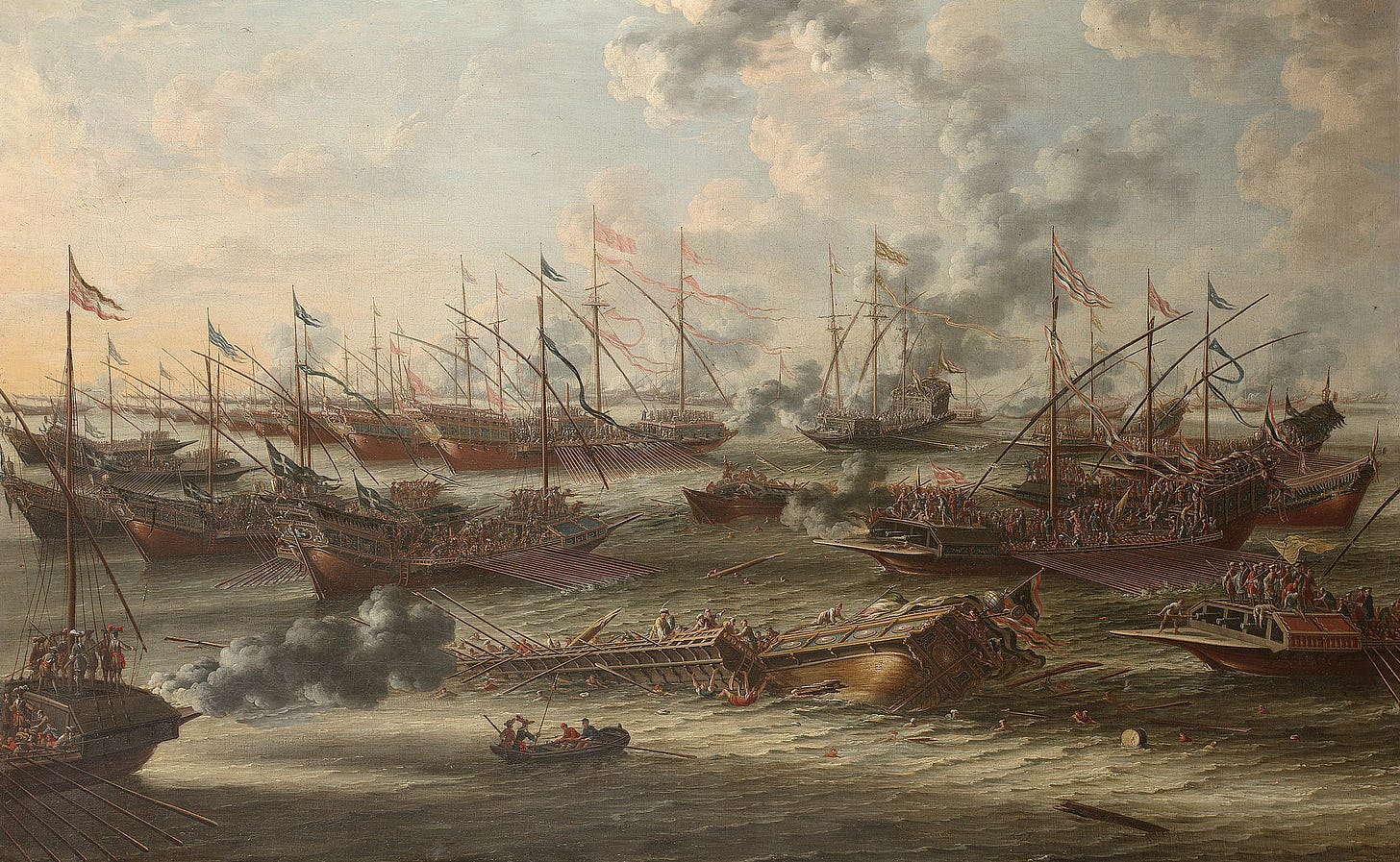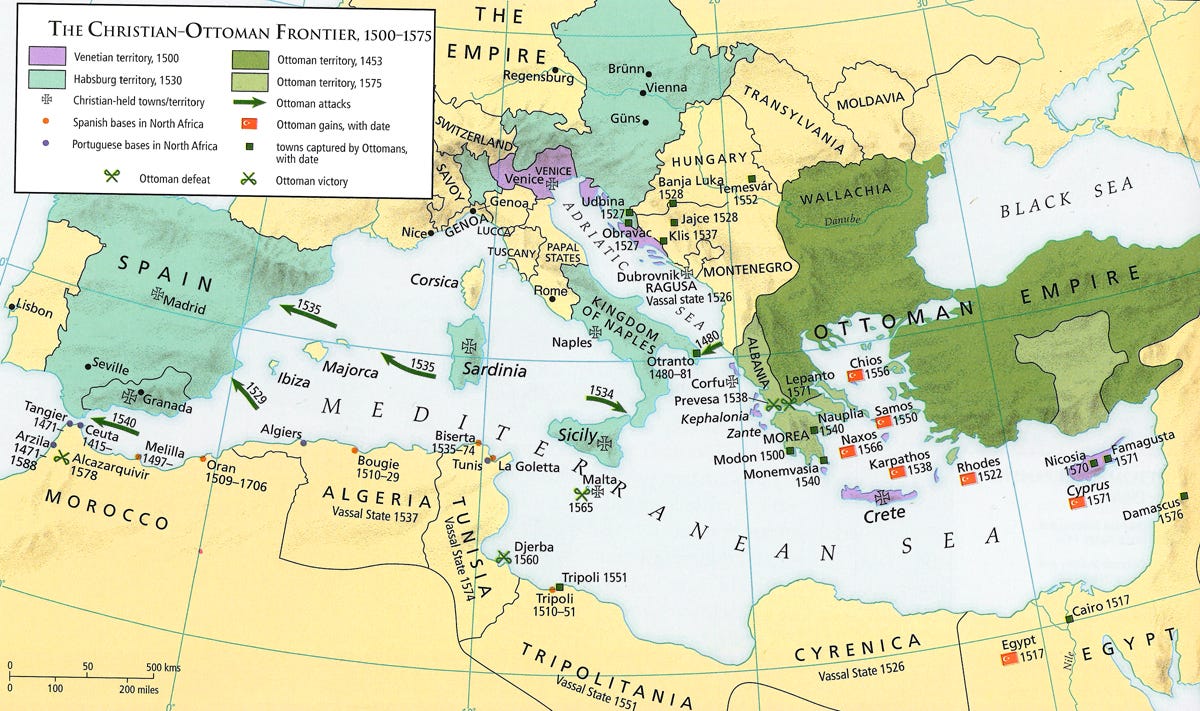Today in European history: the Battle of Lepanto (1571)
The Habsburg-led Holy League defeats the Ottoman navy in a battle that changed the nature of naval warfare.
If you’re interested in history and foreign affairs, Foreign Exchanges is the newsletter for you! Sign up for free today for regular updates on international news and US foreign policy, delivered straight to your email inbox, or subscribe and unlock the full FX experience:
The Battle of Lepanto is the mother lode of historical turning points. It broke the Ottoman Empire’s domination of the eastern Mediterranean and marked a turning of the tide in the long-simmering conflict between the European powers (particularly the Habsburgs) and the Ottomans. It gave European Christians the confidence that they could stand up to the feared Ottomans and actually come away with a major victory.
Well, kind of. I mean, it did those things, more or less, but not suddenly and not even very apparently in the years immediately following the battle. Lepanto had far-reaching impacts, but most of them took a while to really shake out. And one of its greatest impacts actually had less to do with the European-Ottoman conflict than with the way naval warfare would be conducted in the future.
In 1570 and early 1571, the Ottoman Empire made major gains in the eastern Mediterranean, following up on its victories in the battles of Preveza in 1538 and Djerba in 1560. Only the failed Siege of Malta (in 1565) had slowed the empire’s Mediterranean expansion, and even that wasn’t a huge setback. By this point, Ottoman attentions were focused on Cyprus, which was still nominally a Venetian territory though its cities, one by one, were being brought under Ottoman control. When the Ottomans laid siege to the city of Famagusta—the last Venetian city on the island—in September 1570, Pope Pius V assembled a Holy League, just like the one that Paul III had assembled for Preveza. It hadn’t worked then, but if at first you don’t succeed, I guess?
This League looked a lot like the previous one, involving old hands Venice, the Habsburgs, the Papal States, Genoa, and Malta, plus new additions Tuscany, Savoy, and Urbino. It even counted as one of its leaders the Genoese admiral Gianandrea Doria, the great-nephew of Andrea Doria, who had been the Christian commander at Preveza. Overall command was held by a Habsburg prince, John of Austria, the illegitimate half-brother of King Phillip II of Spain. The fleet sailed from the Sicilian city of Messina in early October, which was well after news had arrived of the fall of Famagusta (in early August)—and the decision by the Ottoman commander, Lala Mustafa Pasha, to massacre the city’s Venetian defenders.
Though it may not have been apparent at the time, in hindsight we can say that the Ottoman fleet that met the Christians at Lepanto (modern Nafpaktos) was overmatched. The Christians had fewer ships and fewer men, but they had around two and a half times the number of cannons in their fleet (over 1800 compared to the Ottomans’ ~700), and the soldiers on board the Christian ships were carrying firearms, while the Ottomans were still reliant on what was traditionally their most devastating naval weapon—archers. Yes, the kind with bows and arrows. Basically, the Ottomans were ready to fight a traditional Mediterranean naval battle, while the Christians were ready to fight the kind of naval battle that would become traditional after Lepanto.
In particular, the Christian fleet included six galleasses, which were larger than the traditional galley and were packed with guns along both sides of the ship. Galleys only fired forward and were meant for ramming and boarding an enemy vessel, the way Mediterranean naval warfare had been conducted since the days of the ancient Greeks. The galleass, on the other hand, was a true ship of the line (the term refers to the tactic of lining a fleet’s ships up with their sides facing the enemy), and finally represented a real change in naval technology and, therefore, tactics. A galley captain was trained to maneuver his ship to approach an enemy from the side, where the other ship had no guns and was vulnerable to cannon fire and small arms fire/ramming. A galley captain who tried to do that to a galleass, however, would be sailing right into a broadside cannon volley, and would be unlikely to live long enough to learn from his mistake.
The one problem with the galleass was that because it was big and heavy, it depended on its sails much more than the galleys, which had sails but were still primarily rowed. In bad wind conditions it was possible that your fleet’s galleasses might not even get into the fight. John got around this problem by having his galleasses pulled to the front of his battle line and anchored there, with their broadside guns facing the Ottoman fleet.
Unfortunately for the Holy League, the Christian right wing, commanded by Doria, didn’t get its galleasses into position. Doria was too busy being outmaneuvered by the commander of the Ottoman left wing, Uluç Ali, who feinted south to draw the Genoese admiral away from the rest of the Christian fleet before turning and coming straight at the Christian center. Meanwhile, the commander of the Ottoman right, Mehmed Siroco, managed to outflank the Christian left. So initially, things were not looking great from the Holy League’s perspective.
But those galleasses—at least the ones that did get into position—simply tore the Ottoman fleet apart. At first, the Ottomans seem to have had no idea what they were, because they sailed their galleys directly at them only to lose dozens of ships in the process. Once the Ottomans smartened up, the galleasses pulled anchor and began to chase the Ottoman ships. One galleass, for example, was able to blunt the advance of the Ottoman right pretty much on its own (Siroco was killed in the fighting). In the center, the Christian fleet sent in its reserve element to fend off Uluç Ali, and a Christian counterattack was able to kill the overall commander of the Ottoman fleet, Grand Admiral Sufi Ali Pasha, whose death was a huge blow to Ottoman morale.
At the end of the day, the Ottomans lost over 200 ships, compared to about 50 for the Holy League. Uluç Ali was the only one of the Ottoman commanders to salvage his fleet and get it back to Constantinople, where he was later appointed Grand Admiral and set about reforming the Ottoman fleet along the lines of what he’d seen at Lepanto—bigger ships, more cannons, troops armed with firearms rather than bows, etc.
Now, about Lepanto’s legacy. In the Western telling, the story of Lepanto eventually became a total Christian victory that completely destroyed the Ottoman Empire’s naval capabilities. This grossly oversimplifies things. In fact, the Ottomans had a brand new fleet on the water by the following year, including galleasses that were bigger than the ones sailed by the Holy League at Lepanto. This fleet was powerful enough that Ottoman naval expansion actually continued—Uluç Ali, for example, was able to capture Tunis from the Hafsids (who were a Muslim dynasty but were Habsburg vassals) in 1574, and the empire was able to conquer Crete in the middle of the next century. And lest we forget, the Holy League’s nominal goal—saving Famagusta—was rendered unattainable before the fleet even set sail. The Ottomans controlled Cyprus until the late 19th century. Shortly after the battle, the Ottoman Grand Vizier, Sokollu Mehmed Pasha, is said to have told a Venetian envoy:
In wresting Cyprus from you, we deprived you of an arm; in defeating our fleet, you have only shaved our beard. An arm when cut off cannot grow again; but a shorn beard will grow all the better for the razor.
Well then.
Some of that was bluster, though, because Lepanto did really hurt the Ottomans and did really contribute to changing the balance of power in the Mediterranean in the long term. Yes, the Ottomans had very little trouble rebuilding their fleet, but they also lost thousands of trained, veteran soldiers and sailors at Lepanto, and their training and expertise was not so easy to get back. The Ottomans mostly avoided major naval engagements with Christian fleets for decades after Lepanto (partly because of the state of their fleet and party because they faced a new threat to the east in the form of a resurgent Safavid Empire), and they came off badly in the engagements that did occur. In general, Mediterranean naval warfare began to be characterized less by major massed fleet battles like Lepanto and more by smaller engagements and corsair raids.
By far the biggest thing to come out of Lepanto was the revelation that the Habsburgs had technologically and tactically moved ahead of the Ottomans when it came to naval warfare. Sure, the Ottomans were able to copy the galleasses that they’d encountered at Lepanto, but meanwhile Habsburg Spain, spurred on by the demands of the Age of Exploration and trans-Atlantic travel, was building bigger and more powerful seaworthy vessels, like the massive galleons that most people think of when you talk about sail-powered warships. Ottoman galleys (and yes, they continued to build galleys, mostly because they had no real reason to invest in building huge oceangoing vessels) were simply no match for these kinds of behemoths. Lepanto’s greatest impact on world history was that it was the last major naval engagement to rely primarily on galleys and galley-type ships. From then on naval warfare would be dominated by ships of the line built by the major seafaring powers.



